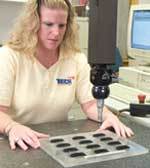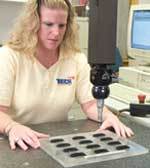Hunting for the Right Shop to Meet Your Reverse Engineering Needs
It is challenging enough to produce a brand-new mold from a tool drawing.
It is challenging enough to produce a brand-new mold from a tool drawing. What happens when the situation is "reversed" - if a customer comes to you with an existing mold he needs duplicated and there are no drawings in existence. Reverse engineering - the process of taking an existing tool and reproducing it - can be a difficult, time-consuming process that is better left to the experts and thus, should be outsourced if your shop lacks the expertise to accomplish this process.
According to George Lyle, tool design manager for Ivyland, PA-based Neu Dynamics Corporation - a manufacturer of precision encapsulation molds and dies for the electronics industry - there are a number of reasons mold shops look elsewhere to have molds reverse engineered. "Perhaps the moldmaker doesn't have its own in-house tool facility, or perhaps their in-house tool shop is strictly there to maintain the equipment they are using in production," he says. "Also, a lot of shops don't have tool designers - they have part designers, product designers, program designers - but no tool designers."
Reverse engineering is a big challenge for most moldmaking shops, Lyle says. "When you start with a part drawing and build a tool around it, you know where you are going," he states. "With tool steel, there are a lot of little things that just don't show up on a part drawing, that come into play when you fabricate the tool. In a reverse engineering situation you have to reproduce those 'little things' in the new tool to ensure that it's exactly like the old one."
Lyle feels the only way to duplicate an existing mold is to find a designer with the right experience to perform the reverse engineering process. "You need someone who has the confidence and knows the steps required to refabricate a tool - someone with years of experience," he emphasizes. "The designer really has to know what he is doing, if he doesn't, things can get very ugly and often quite expensive. Time is often a critical element in reverse engineering, so the designer must be able to jump into the program and get the designs done as quickly as possible so the tool shop can get working on refurbishing or reengineering the tools."
Matchmaking 101
When hunting for the right shop to meet your reverse engineering needs, Lyle recommends first finding out what the tool shop specializes in. "Many tool shops specialize in one area," he notes. "To sub out reverse engineered extrusion molds to a shop that specializes in blow molding would be ludicrous because that tool shop - even though they might want to take the job - is going to use your project as a learning curve and mistakes are bound to be made. Customers just can't afford that with today's deadlines."
Second, look for a shop with designing capabilities and toolmaking capabilities, and make sure the person that will be reverse engineering the mold has enough experience to get the job done right the first time. Always ask to see examples of reverse engineering or check testimonials.
Once you feel you've found someone, it's time for a face-to-face meeting, according to Lyle. "In some instances, the tool can't be taken out of production immediately; and we have to travel to the facility. The mold will be shut down for half a day while we look it over carefully and write up a description of what has to be done to the tool in order to bring it back to first-class shape again. After this meeting, we will then do a write-up on the tool - noting what has to be refurbished and what has to be remanufactured from scratch.
"Then, the customer will send the tool in, at which time we will disassemble it; clean it up and then start to take accurate measurements in the critical areas," Lyle continues. "At this stage, we are on our own for awhile while we get all of the preliminary numbers. We often take a tool apart and find certain things we couldn't see during the preliminary meeting. The next step is to get back to the customer and give him a really accurate account of the condition of the existing tool and the costs involved in reengineering. For example, certain inserts may be cracked, and the customer needs to know the additional costs right away.
"There should be a lot of give and take between the customer and the outsourcing tool shop," Lyle adds. "There's often going to be a surprise with a tool that's been out in the field for four or five years, running day in and day out - poor maintenance can lead to major problems, no matter how well the tool was originally designed and manufactured."
After the tool has been disassembled and analyzed, "We'll then discuss the costs and time for fabrication of the tool," Lyle says. "It's wise to build in a couple of check points during the reengineering process, because the further into the project the designer gets, the more likely he is to find more things that need additional time and attention."
Trust is the bottom line, asserts Lyle. "It's definitely not like quoting a new tool that is cut and dried with no surprises," he says. "To refurbish a mold we have to evaluate it and reevaluate it a couple of times before all of the dust settles, and it's important the moldmaker feels comfortable with the outsourcer. We feel obligated to let the customer know the exact condition of the tool and all of the different options required in order to bring the tool back to serviceability. Then, it's up to them to decide if they want to go through with the add-ons or not."
So, moldmakers should rest assured. There's no need to turn down a job just because there are no original tool drawings and you lack the equipment and the expertise to refurbish the tool yourself. Find a shop with an experienced team of reverse engineering designers and production personnel - they will make your life a lot easier and help to keep your customers satisfied.
Related Content
Tolerancing in Mold Design, Part 1: Understanding the Issues of Conventional Bilateral Tolerancing
Mold designers must understand the location, orientation and form limitations of conventional tolerancing before changing to another dimensioning system.
Read MoreMold Innovations Power Unique Auto Lighting Elements on Hummer EVs
Diamond machining, electroforming of micro-optical inserts and modified latch-lock system help injection molds produce unique forward lighting elements.
Read MoreHow to Improve Your Current Efficiency Rate
An alternative approach to taking on more EDM-intensive work when technology and personnel investment is not an option.
Read MoreThe In's and Out's of Ballbar Calibration
This machine tool diagnostic device allows the detection of errors noticeable only while machine tools are in motion.
Read MoreRead Next
A Better Reverse Engineering Approach when Modifying Molds
Laser scanning services make good economic sense as they provide precise CAD data available for robot programming, which shortens the actual programming process.
Read MoreReasons to Use Fiber Lasers for Mold Cleaning
Fiber lasers offer a simplicity, speed, control and portability, minimizing mold cleaning risks.
Read MoreAre You a Moldmaker Considering 3D Printing? Consider the 3D Printing Workshop at NPE2024
Presentations will cover 3D printing for mold tooling, material innovation, product development, bridge production and full-scale, high-volume additive manufacturing.
Read More













.jpg;maxWidth=300;quality=90)






_300x250 3.png;maxWidth=300;quality=90)







